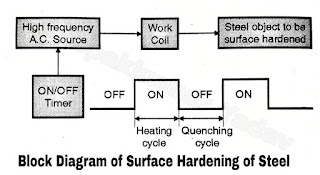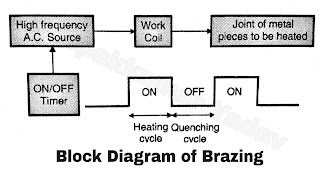Applications of the Induction Heating
Q. Induction Heating Applications
Q. Induction heating
Q. Applications of Induction Heat Treating
Induction heating is used in many industrial applications, some of them are listed here :
- Surface hardening of steel.
- Annealing of brass and bronze items.
- Soldering.
- Brazing.
1. Surface hardening of steel :
- In induction heating heat is concentrated near the surface of the job so it is ideally suited for surface hardening of steel. It is preferred to conventional method i.e. case hardening because conventional method has many drawbacks.
- In conventional method the steel job is packed in carbonaceous material and heated at red-hot condition for several hours.
 |
| Figure A |
- In case of hardening interior part of the job gets distorted. Also it leaves scaly surface on the job being heated.
- Long and thin jobs face difficulty in wrapping and heating with conventional method. All these drawbacks can be eliminated by using induction heating method.
- In induction heating method the steel bar to be surface hardened is placed in strong ac magnetic field, which is generated by a water-cooled helical coil (work coil) made of copper tubing.
- The arrangement for this is shown in the diagram. A heavy current at 400 kHz frequency is passed through the work coil for about 5-10 sec.
- When the temperature of the surface up to desired depth reach the required level, the current flowing through the work-coil is stopped. And the job is immediately quenched either in the oil or in the water. Due to surface hardening interior part of the job remains unaltered.
- In hardening process the temperature should be suddenly dropped i.e. quenching. Water or oil is used for quenching of the jobs upto power concentration below 1 kW/ Cm2.
- In high power applications quenching takes place automatically because temperature gradient within the metal is extremely large.
- Surface hardening is used for the jobs such as crankshafts bearings, camshafts bearings, cams, gear teeth, cylinder surfaces, cultivator blades, saw blades, knives, plough shares, surgical needles etc.
 |
| Figure C |
- Due to various operations such as rolling, punching, spinning carried out on the job at room temperature, the materials brass and bronze becomes hard and brittle.
- So any further operations carried out on this job may cause its breakage. Therefore before going to such further operations the job has to be brought to the normal condition. This is achieved by using the process of annealing.
- In conventional method of annealing the job is heated in the furnace at 6000° C temperature for about 1 hour. In this process the surface becomes scaly and time taken is also very large.
- In induction heating method used for annealing the time taken is less about 1 minute for rods of diameter about 1 inch. Surface will not become scaly due to short heating period.
- Heat loss due to radiation and convection is less. So it is efficient method as compared to conventional method.
3. Soldering :
- Soldering is the method used for making the joints at low temperature of soft solder metals.
- The solder metals are formed by using tin Sn and lead Pb. In this method base metal such as copper or aluminium is not required to heat, but only solder metal is melted and the joint is formed with the base metal.
- As shown in the block diagram the high frequency AC source is provided to the work coil, which is used to generate the heat in the solder gun tip.
- The heat generated is used to melt the solder metal to form the joint.
 |
| Figure D |
4. Brazing :
- Brazing is high temperature soldering by using silver, copper or its alloys as solder material. This process can be used for joining together two pieces of steel or iron or other fabrication materials.
- In brazing process first the joint is provided with suitable oxide reducing flux. Then a piece of solder is placed near the joint and heating of the joint is carried out rapidly.
- Due to heating the solder melts and runs into the joint which forms high conductivity joint after cooling of the joint area. Brazing process using induction heating is an economical process.
 |
| Figure E |
5. Induction cooking :
- The principle of eddy current cooking is that a highly intense pulsating magnetic field is obtained (generated) by applying a high frequency ac current to a work coil.
- The cooking ware like metal pan etc. is placed in close vicinity of this intense magnetic field.
- The cooking ware then gets heated up due to principle of induction heating.
Induction heating may be used for welding, drying paints on metals, bonding clutch facings, sintering powdered metals, sterilizing surgical instruments etc.
